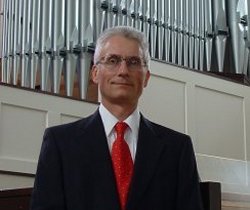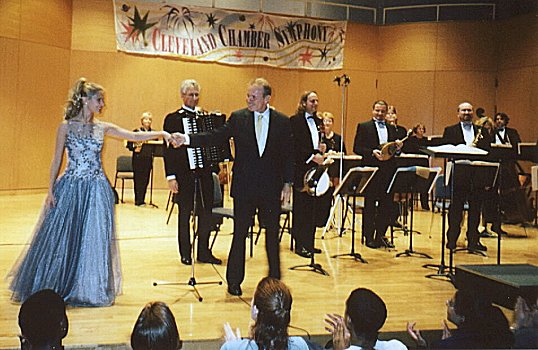
| | Organist | Accordionist | Composer | Conductor | Author | Educator |

 |
Henry Doktorski
|
 |
David Del Tredici: Vintage Alice 1-13. Vintage Alice (23:00)
1. Narration
14. Dracula (21:46)
2. First Evocation of the Queen
3. Cadenza I
4. The Mad Hatter's Song, Verse I
5. Second Evocation of the Queen
6. Cadenza II
7. The Mad Hatter's Song, Verse II
8. Interlude
9. Changing Places
10. Cadenza III
11. Quodlibet-Return
12. Hymn to the Queen
13. Sleeping-Coda
Total Time: 47:38
Henry Doktorski performs accordion on a newly-released compact disc featuring soprano Hila Plitmann and the Cleveland Chamber Symphony. The album, released in April 2008 by INNOVA—The label of the American Composers Forum—features two works by American composer David Del Tredici: Vintage Alice and Dracula.
At first blush there may not seem to be much of a connection between the worlds of Alice in Wonderland and Dracula. Geographically speaking they are as far apart as Oxford and Transylvania; Hormonally, there is no comparison. Even their beverages of choice—tea and blood respectively—celebrate different themes.
Yet both legends deal with the curiosity of nineteenth century young virgins, and, pertinent to the present case, both have been set to music by the grandmaster of gothic Neo-Romanticism himself, David Del Tredici (b. 1937). In these settings for soprano-narrator and chamber orchestra he conducts the Cleveland Chamber Symphony with the emotionally charged Hila Plitmann as soloist.
Vintage Alice–so named because it was commissioned by the Paul Masson Winery–dates from 1972 and is the fourth of his treatments of Lewis Carroll’s Alice books. It focuses on the Mad Hatter’s Tea Party scene and you will hear delicious parodies of God Save the Queen and Twinkle, Twinkle, Little Star, more chaotic than a room full of Suzuki students could ever achieve.
The whole enterprise is so sublimely silly and so skillfully executed that it's hard not to give in to its charms and just guffaw, or at least smile. Del Tredici is a master of creating a highly sophisticated but immediately communicative sense of the absurd, and he has impeccable comic timing. His sure sense of drama is perhaps even more clearly evident in Dracula, written in 1998 for the Eos Orchestra and the Cleveland Chamber Symphony, based on the poem "My neighbor, the distinguished guest" by Alfred Corn. The piece is flamboyantly melodramatic, and vacillates between macabre humor and genuinely sinister moments.
Soprano Hila Plitmann's performance is stunningly virtuosic and hilarious–she's a genuinely talented comedienne, and the subtleties of her speaking voice are as finely tuned as her brilliant and supple coloratura. (Dracula has a range of over three octaves, which she executes without any apparent strain.) The composer leads the Cleveland Chamber Symphony in polished and exuberant performances. The sound is generally clean. ~ Stephen Eddins, All Music Guide
Hila Plitmann has been praised by the New York Times for her “brilliant top register”; the Los Angeles Times calls her “exceptionally gifted” and the Chicago Tribune has described her as “...superb, with an expressive range and communicative power.” She has performed as featured soloist with ensembles such as the New York Philharmonic, the Los Angeles Philharmonic, the Chicago Symphony and the Atlanta Symphony Orchestra. Among numerous recordings, she's appeared as soloist in three recordings that have received Grammy nominations for 2007, one of which is the soundtrack to the Hollywood blockbuster The DaVinci Code.
Generally recognized as the father of the Neo-Romantic movement in music, David Del Tredici has received numerous awards (including the Pulitzer Prize) and has been commissioned and performed by nearly every major American and European orchestral ensemble. “Del Tredici,” said Aaron Copland, “is that rare find among composers – a creator with a truly original gift. I venture to say that his music is certain to make a lasting impression on the American musical scene. I know of no other composer of his generation … who composes music of greater freshness and daring, or with more personality.”
Vintage Alice, a 23-minute work scored for orchestra and a folk group consisting of two saxophones, mandolin, banjo and accordion, is based on text drawn from Lewis Carroll's Alice in Wonderland. The composer spoke about the accordion in his oeuvre: "When I began writing my musical setting of Alice In Wonderland for orchestra, I wanted to include a second group of instruments which would sound completely different from a symphony orchestra; something totally un-orchestral. After some consideration, I decided that the saxophone, mandolin, banjo and accordion would be perfect because those instruments–due to their cultural identity and distinctive tonal qualities–were rarely used with symphony orchestras."
Del Tredici continued, "Believe it or not, I actually love the accordion; to me at least, it always sounds funky in an orchestral setting. It's sound is quite unique. In my Alice pieces, I write for the accordion as a solo instrument and never try to blend it with the other instruments. Early in my composing career I wrote mostly atonal works. But when I discovered the accordion I developed a desire to use its left-hand chord buttons–the major, minor, seventh and diminished buttons–in my Alice In Wonderland piece. This was a turning point for me: it caused me to consider using tonality in my compositions. I suppose for this then, I am indebted to the accordion for opening my eyes to the possibilities of tonality."

Soprano Hila Plitmann and composer/conductor David Del Tredici. Doktorski said, "The accordion part was substantial: some two dozen pages of music. It was one of the most difficult accordion pieces I have played with orchestra–due to the presto tempo and convoluted right and left-hand passages (after all, it was a mad tea party), but that simply made the performance even more exciting.
"For much of the piece, the accordion, banjo and mandolin functioned as a trio within the orchestra; at several other places, the accordion was featured as a solo instrument and even had its own cadenza toward the end. My favorite part was the accordion and soprano duet near the conclusion of the piece, a classical-period stylistic variation on the Twinkle Twinkle Little Star melody (which figures prominently throughout the piece) which was pure pleasure to play."
This compact disc can be ordered online or from any classical CD store.
Back to Discography Back to The Homepage of Henry Doktorski